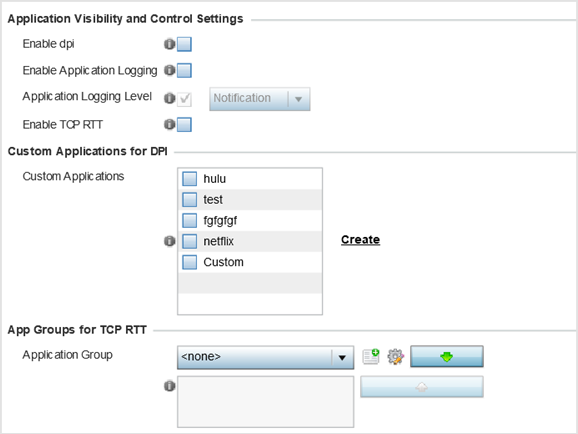Deep packet inspection (DPI) is an advanced packet analysis technique that analyzes packet and packet content headers to determine the nature of network traffic. When DPI is enabled, packets of all flows are subjected to DPI to get accurate results. DPI identifies applications (such as, Netflix, Twitter, Facebook, etc.) and extracts metadata (such as, host name, server name, TCP-RTT, etc.) for further use by the WiNG firewall.

Note
Configure Application Visibility settings on legacy WiNG, 802.11ac APs, running WiNG 7.2.1 OS. These APs are: AP7502, AP7522, AP7532, AP7562, AP8612, AP8632, AP8662, AP8432, AP8533.
Note
Configure Purview Application Visibility settings on 802.11ax APs, running WiNG 7.2.1 OS. These APs are AP505i, AP510i/e, AP560i/h. Refer the WiNG 7.2.1 CLI Reference guide for information on Purview Application Policy.To override an access point profile's AVC configuration:
The Device Overrides screen displays. This screen lists devices within the managed network.
The selected access point's configuration menu displays.

Note
A blue override icon (to the left of a parameter) defines the parameter as having an override applied. To remove an override go to the Basic Configuration section of the device and click Clear Overrides. This removes all overrides from the device.
The Application Visibility (AVC) configuration screen displays.

| Enable dpi | Enable this setting to provide deep-packet inspection (application assurance) by inspecting every byte of each application header packet passing through the controller or service platform. When enabled, application data streams are inspected at a granular level to help prevent viruses and spyware from accessing the WiNG managed network. |
| Enable Applications Logging | Select this option to enable event logging for DPI application recognition. This setting is disabled by default. |
| Applications Logging Level | If enabling DPI application recognition event logging, set the logging level. Severity levels include Emergency, Alert, Critical, Errors, Warning, Notice, Info, and Debug. The default logging level is Notification. |
| Enable Voice/Video Metadata | Select this option to enable the metadata extraction from voice and video classified flows. The default setting is disabled. |
| Enable HTTP Metadata | Select this option to enable extraction of metadata from HTTP application data flows. The default setting is disabled. |
| Enable SSL Metadata | Select this option to enable extraction of metadata from SSL application data flows. The default setting is disabled. |
| Enable TCP RTT | Select this option to enable extraction of RTT information from TCP flows. The default setting is disabled. |
For information on creating custom applications and their categories, see Create a Custom Application Definition.
If the desired application group is not available, select the Create icon to define a new application group configuration or select the Edit icon to modify an existing application group. For information on creating Application groups, see Create a Custom Application Definition.